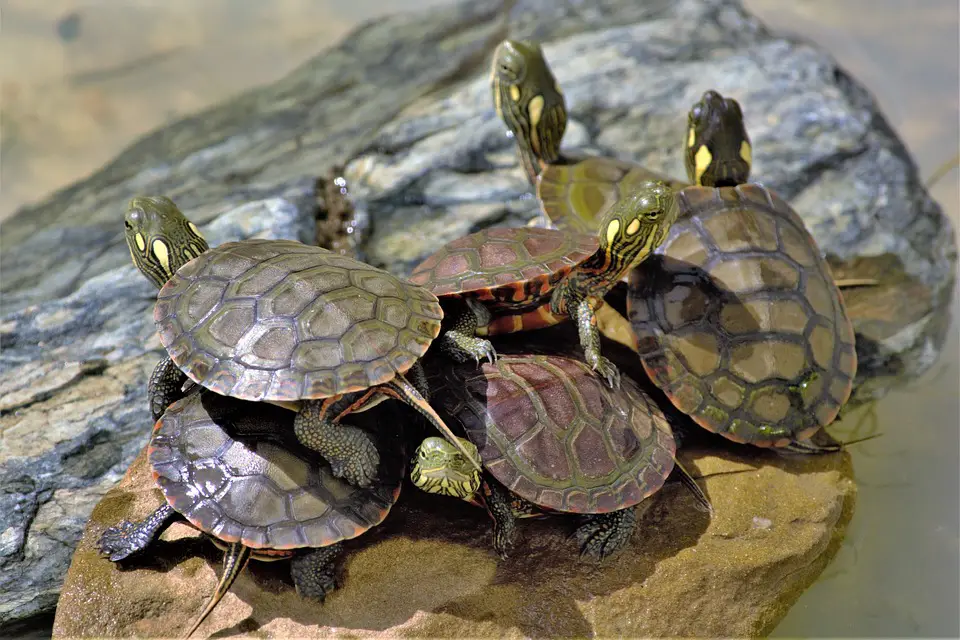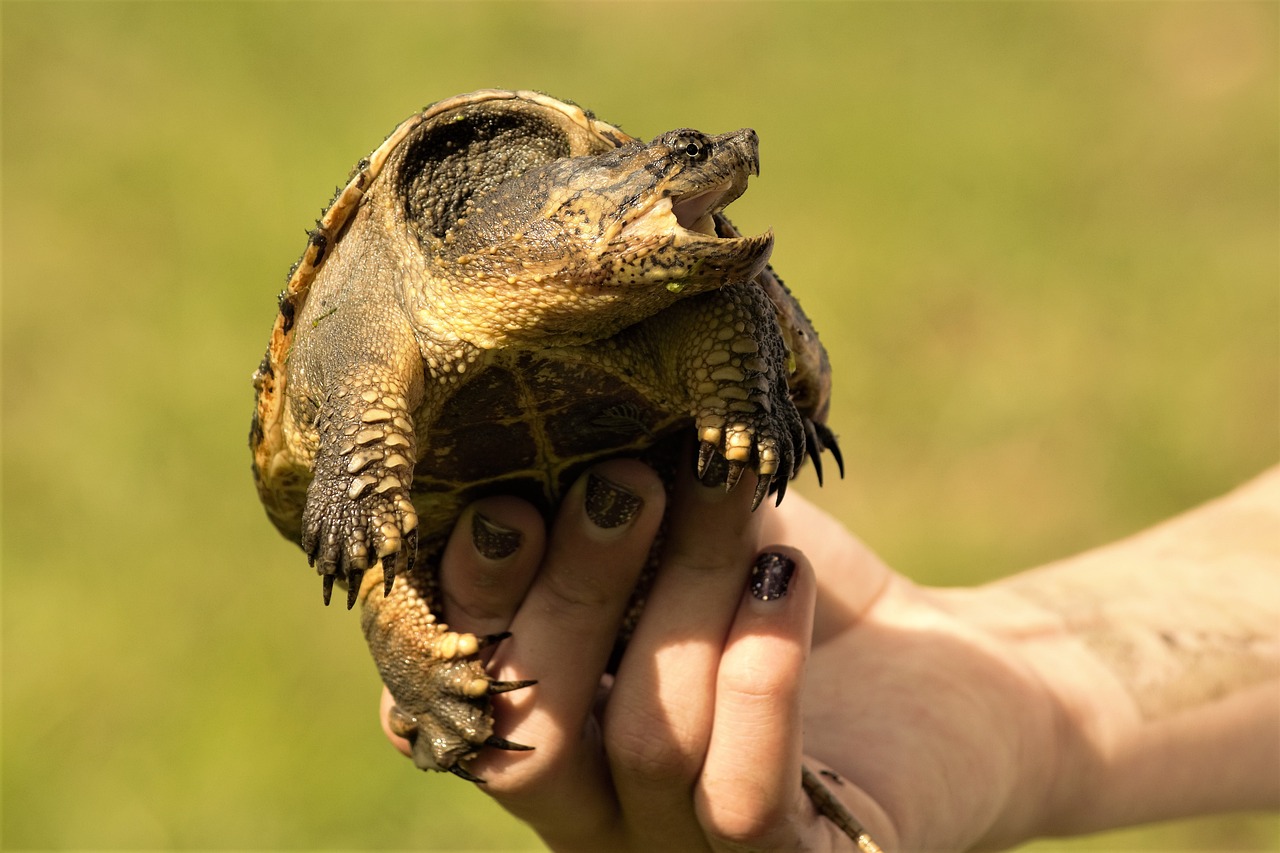How Fast Do A Painted Turtle Grow?

As a beginner turtle owner, it’s pretty normal for you to be concerned about the growth of your new reptile friend. Painted turtles are very delicate creatures. So keeping them as pets require tons of dedication and knowledge.
In this article, I’ll be talking about how fast painted turtles grow, what factors influence their growth and other growth-related facts that may be useful to you.
In captivity painted turtles will grow 2 to 4 inches in their first year. And from then they’ll grow about 0.5 inches per year.
But these are approximate statistics. It’s not the same for all painted turtles. The growth of turtles depends on several factors. Knowing and understanding these factors is important for you to provide proper care for your painted turtles.
Here is all the information you need to make sure your turtles are in tip-top shape.
The Turtle Anatomy
You can’t talk about a turtle’s growth before talking about its anatomy. There are a few terms you need to be acquainted with before we move on. To learn about its growth you need to focus on 3 parts:
- Carapace: It’s the top part of the turtle’s shell. Carapace is usually dark green, black or blackish-brown. It’s smooth and may have red, yellow or black patterns. It’s a distinguishing characteristic of the painted turtle.
- Plastron: The plastron is the bottom part of the turtle’s shell. This part of the shell is very important for determining the turtles age and size. It’s yellow with some black or red markings.
- Scutes: These are the scales of the top shelf.
Periods Of Growth
The painted turtle’s growth period can be divided into three stages:
- Pre-mature: This stage starts when the turtle is just a hatchling and ends at full sexual maturity. As a hatchling, they are approximately 18-30mm long. About the size of a nickel. The growth rate is fastest at this stage.
- Mature: Male and female turtles enter sexual maturity at different ages. The males enter maturity within 3 to 5 years and are usually 70-100mm long. For females, maturity occurs at 6-11 years and they are 100-135mm long.
- Post-mature: After maturity, the growth rate slows down drastically to 0.5 inches per year or lower. The growth may even stop at some point after a painted turtle is fully mature. They can live up to 30-40 years in captivity.
Factors Influencing Painted Turtle Growth
The growth of painted turtles is influenced by various factors. These include diet, genetics, age, sex, sunlight, etc. Being highly sensitive creatures these factors can play a part in your painted turtle’s growth.
Diet:
It’s a no brainer that no matter what animal we’re talking about its diet is the number one deciding factor of its growth. And it’s the same for painted turtles. Without a proper diet plan, your turtle will suffer from malnourishment and hampered growth.
Painted turtles are omnivores. It means they eat vegetables, fruits, and meat. You should be glad to know that because it makes providing a balanced diet to your turtle easier. The two most important components of your turtle’s diet should be protein, calcium and Vitamin D.
Protein is very important for painted turtles. It helps turtles grow stronger muscles. It helps in the development of the shell. A lack of protein will cause growth abnormalities. About 30 to 40 percent of its diet should contain protein.
But make sure you’re not providing too much protein as it may cause a disease called pyramiding. It causes deformation of the shell. The shell develops pyramid-shaped deformities.
Calcium is another important component of a turtle’s diet. It helps in the development of bones. It is also important for the proper functioning of the heart, muscles, and nerves. There is no accurate amount to how much calcium your turtle needs as each painted turtle grows differently.
My advice will be to provide them with plenty of calcium-containing food and check for calcium deficiency related defects. It’s also necessary that you make sure your turtles are getting enough phosphorus and vitamin D3 as these are linked with the absorption of calcium (Vitamin D3) and formation of bone (Phosphorus).
Another thing to mention is that make sure the food you provide are low in oxalates (Oxalic acid). Oxalates bind to calcium and prevent their absorption. This may lead to the formation of bladder stones. Spinach, Rhubarb, raspberries, etc contain high amounts of oxalates. It’s good to google the food you plan to give your turtle and check if it has too many oxalates.
Here’s a short list of food that you might consider including in your painted turtle’s diet:
- Fruits
- Vegetables
- Meat
- Fish
- Insects
- Worms
- Pallets
- Lettuce
- Water hyaline
- Duckweed
Besides organic foods, you can also provide commercially available foods from time to time. But organic food is understandably healthier for your turtle. It’s also good to provide live food like small fish and insects as it engages them physically and mentally.
You might find young turtles avoiding vegetables and preferring a more carnivorous diet. Don’t be alarmed. Young turtles grow very rapidly and require large amounts of protein. This high demand for protein drives them to have an increased appetite for meat.
Genetics:
Genetics is very important for your painted turtle as well. Sometimes providing a balanced diet is just not enough. Your turtle will not grow more than it is genetically determined to be.
So if your turtle seems a bit small to you, don’t be alarmed. Provide a balanced diet, check for deficiency-related defects, provide adequate sunlight and your turtles will have a healthy growth.
Environment:
Turtles are very different from humans. So if you’re planning on keeping them inside you must understand that your house may be comfortable for you but the same cannot be said for your turtle.
Here are the things you should consider to provide a proper environment for your painted turtles:
Sunlight:
Sunlight or more specifically UV-B helps turtles to produce Vitamin D3. Vitamin D3 helps with the absorption of calcium and various other nutrients. Without adequate sunlight their growth will be hampered, they’ll suffer from calcium deficiency, reproductive capabilities will be hampered and may cause physical abnormalities.
So allow your turtles to receive 12 hours of UV-B every day. If getting that much natural sunlight isn’t possible. Consider buying a UV-B bulb. That will get the job done.
Water:
Provide your turtle tank with clean water. Turtle require clean water to swim in and drink. You will need 20 gallons of water for one turtle. If you have more than just add 10 gallons for every additional turtle.
Space:
You turtle needs adequate space to maintain a healthy lifestyle. Inadequate space will cause hampered growth. It can sometimes cause dystocia a condition which causes a mother painted turtle to hold in her eggs. This can cause several health issues.
The tank should be 4 times wider the turtle’s size (about 35-50 inch) and 2 times deeper than its length (about 12 inches). If you have more than one turtle than just increase the dimensions by 25% for each turtle.
Shelter:
Your turtles will need a shelter to simulate its natural lifestyle. In nature, turtles have small underwater shelters made of aquatic plants to rest and hide from predators. And your pet turtle might also want to do that. You can use real or fake plants to build your buddy an underwater shelter.
Basking Spot:
A basking spot is very important for indoor turtles. I said before, turtles need a lot of sunlight for proper growth. You can use driftwood or smooth rocks to build a basking spot. There are plenty of YouTube videos to help you build one yourself. Make sure the UV-B bulb cover the whole basking area.
Here is one of my article reviewing penn plax turtle topper basking platform, which I absolutely love!
Sex:
The sex of your turtle also determines its growth. Usually, females grow larger up to sexual maturity than males.
Age:
The turtle’s age is an important determinant of its growth rate. Since birth up to sexual maturity turtles growth rate will be fastest. In the first year, they’ll grow to 2 to 4 inches. After fully matured the growth will slow down to 0.5 inches per year or less.
Process Of Growth
At birth, a hatchling painted turtle will be the size of a nickel and in the first year 2-4 inches. To support this rapid growth, baby turtles will prefer a protein-rich diet. This protein is used to develop their shell and muscles.
The shell has 13 scutes, which during development, shed their outermost layer. In the meantime, a new plate forms underneath which is larger and stronger than the previous. The turtle’s bones and muscles also develop simultaneously. The growth rate decreases as the turtle reach maturity and slow down even more or completely stops post-maturity.
How To Measure Your Painted Turtle?
When we talk about the size of a turtle, we mean the size of its plastron. Keeping check of your painted turtle’s size is very useful to make sure that the turtle is getting enough nutrition.
This is how you measure a turtle:
- Flip your turtle upside down. Don’t keep it at that position for too long. Remember, in nature an upside-down turtle is a dead turtle. So this position may cause your turtle to get stress out. The tortle may hiss or even try to bite. So do the measurement as quickly as possible.
- Grab a measuring tape and start measuring from the tip of the plastron.
- Drag the tape up to the end of your plastron and take the measurement.
- If you want to measure the carapace do the same as before. Only this time you’ll start from the carapace tip and measure up to the end of your carapace.
Congratulations! You successfully measured your turtle.
Determining The Age Of Your Painted Turtle
Comparing the size of your pet painted turtle with its age is a great way to understand its growth. Checking this from time to time will allow you to understand whether you need to add or remove something from its diet plan. And this is how you can determine the turtle’s age:
- Flip you turtle upside down. As mentioned before this is uncomfortable for the turtle so act quickly.
- On the plastron look for the abdominal area. It’s located in the middle at the lower half. There are 8 sections of the plastron. Choose the 3rd section. It will have 2 halves.
- Choose one of the halves.
- There are rings on that half. Count all the rings.
- Remove 1 from the number of rings you’ve counted. That’s the age of your turtle. (For example, if you counted 6 then your turtle is 5 years old)
Keep in mind, this method only works for homegrown turtles. It will not provide an accurate value for wild ones. And even in case of homegrown turtles, this may be inaccurate as they may have a growth spurt.
There is not really an accurate way to tell a turtle’s age other than counting since birth. Scratches and marks on the turtle’s shell can give a good estimation for older turtles.
Why Wild Turtles Grow Slower Than Pet Turtles?
It’s common knowledge that wild painted turtles grow much slower than pet turtles. This is due to mainly two reasons: Temperature and Food.
In the wild, turtles put a break in their growth period. Turtles are ectothermic. Which means they can’t produce heat internally. So they are at mercy of their environment when it comes to heat. Turtles hibernate in winter. During this time, their metabolic rate really slows down and growth stops.
On the other hand, pet turtles don’t need to be at mercy of nature. They are provided an artificial source of UV-B, heat and adequate amounts of food. As a result, they don’t need to hibernate. Every year pet turtles get 12 whole months to grow while wild turtles get about 9 months.
Also, turtles in the wild don’t get a fully balanced diet as food is scarce and they have to scavenge for them.
So plenty of food, UV-B, heat and a constant caretaker (Like yourself) to provide a balanced diet allows pet turtles to grow faster and bigger than their wild counterparts.
Final Words…
By now, you’ve learned all that you need to know about the growth of your painted turtles. Provide proper care, plenty of food, a safe healthy environment and you can be sure that your painted turtles will grow fast, strong and healthy.

![What Human Foods Can Turtles Eat? [Food Chart] What Human Foods Can Turtles Eat? [Food Chart]](https://spreadhapiness.b-cdn.net/wp-content/uploads/2024/03/eating-1.jpg)









![Turtle Vs. Tortoise Vs. Terrapin [Difference Chart] Turtle Vs. Tortoise Vs. Terrapin [Difference Chart]](https://spreadhapiness.b-cdn.net/wp-content/uploads/2024/04/terrapin-1-120x120.jpg)




![How Can I Ship My Turtle? [Foolproof Guide] How Can I Ship My Turtle? [Foolproof Guide]](https://spreadhapiness.b-cdn.net/wp-content/uploads/2024/04/4.-1-120x120.jpg)